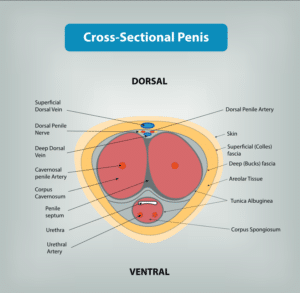When individuals opt for penis girth enhancements through soft-tissue filler injections, they may encounter a rare post-procedural complication, including the formation of nodules. These nodules, which can manifest with any type of filler, are broadly categorized into noninflammatory and inflammatory types, each with distinct etiologies and clinical presentations.
Noninflammatory nodules
Noninflammatory nodules typically emerge soon after the injection procedure and are often attributed to the technique employed, such as the injection depth, the amount of filler used, or its specific placement within the tissue. These nodules represent the body’s immediate physical response to the introduction of a foreign substance. They are generally benign and may resolve on their own or require minimal intervention. If the case of HA fillers they can be treated with hyaluronidase.
Inflammatory nodules
Inflammatory nodules, in contrast, present a more complex scenario and can arise days to years following the filler injection. The pathogenesis of these nodules is multifaceted, involving mechanisms such as foreign-body reactions, immune-mediated delayed hypersensitivity, and infectious processes. which may be initiated or exacerbated by bacterial contamination at the time of injection. Delayed inflammatory responses to dermal fillers, characterized by tissue hardening, swelling, painful lumps, and changes in skin color at the injection sites, have been observed more frequently in the context of COVID-19. These reactions can arise unexpectedly, from days to months after the filler procedure, and their exact causes remain largely elusive. The increased incidence of such reactions during the COVID-19 pandemic has drawn attention to the potential role of immunogenic triggers in these complications. Specifically, the correlation between COVID-19 infections, and possibly vaccinations, with the onset of localized inflammatory responses at filler sites suggests that the immune system’s heightened response to the virus may also be impacting areas treated with fillers.
Foreign-body reactions are a natural immune response to any non-native material introduced into the body. Depending on the filler’s composition and the host’s immune system, this reaction can range from minimal macrophage activity to a full-blown foreign-body granulomatous response, characterized by significant fibrosis and the formation of granulomas. Granulomas are an attempt by the immune system to isolate and encapsulate the foreign material, which it is unable to degrade or eliminate quickly. This reaction can vary significantly based on the type of filler used; for example, PMMA fillers might provoke a more pronounced macrophage response, while HA fillers tend to elicit a lymphocytic response.
The composition of the filler, including factors like particle size, shape, and its biodegradability, plays a crucial role in determining the immune response. Highly biodegradable fillers are generally designed to be absorbed and metabolized by the body over time, minimizing the risk of a severe foreign-body reaction. However, non-biodegradable fillers or those with components that resist rapid breakdown can lead to more persistent and pronounced immune responses.
Delayed inflammatory nodules
Delayed inflammatory nodules have a more insidious onset, typically developing weeks to months after the initial filler injection. Clinically, these nodules can present as firm, sometimes tender masses that may or may not be accompanied by erythema or edema. The exact etiology of these nodules is still a subject of ongoing research, but current theories suggest a combination of factors, including the filler’s physiochemical properties at the time of degradation, the patient’s unique immune characteristics, and the potential for low-grade bacterial contamination during the procedure.
Hyaluronic acid (HA), a commonly used filler material due to its compatibility with human tissue and reversible nature, has been closely studied in the context of delayed inflammatory nodules. Although HA is naturally found in the human body and is generally considered non-immunogenic, the manufacturing process, which involves chemical cross-linking to enhance its longevity and stability, can alter its immunogenic potential. Variations in cross-linking techniques, HA chain lengths, and particle sizes can influence the filler’s rheological properties, hydrophilicity, and resistance to enzymatic degradation, thereby affecting its interaction with the host’s immune system.
Moreover, the role of bacterial biofilms in the development of chronic nodules and granulomatous inflammation cannot be overlooked. Filler materials can serve as a nidus for bacterial colonization, leading to the formation of biofilms. These complex bacterial communities are enveloped in a protective matrix, rendering them highly resistant to antibiotics and immune clearance. Biofilms can result in persistent, low-grade infections that are challenging to diagnose and treat, often requiring a multifaceted therapeutic approach.
Nodule Treatment
The management of filler-induced nodules is nuanced and depends on the underlying cause. Initial strategies may include the use of broad-spectrum antibiotics to address potential infectious etiologies. For noninfectious inflammatory nodules, treatments may involve oral steroids to reduce inflammation, hyaluronidase injections to dissolve HA fillers, and intralesional corticosteroids to target persistent nodules. In cases of biofilm-associated infections, a combination of antibiotics, anti-inflammatory agents, and possibly surgical intervention may be necessary.
Given the complexity of filler-related nodules and the potential for significant cosmetic and psychological impact, a thorough understanding of their etiology, prevention, and management is essential for both practitioners and patients. In light of these rare but significant complications, it’s crucial to choose a provider with extensive experience in managing the entire treatment process, including potential adverse reactions. Dr. Sullivan at GetMoreGirth exemplifies such expertise, offering not only advanced filler treatments but also comprehensive management of the occasional complications that may arise. His proficiency in addressing these issues ensures that patients receive not only high-quality aesthetic enhancements but also the peace of mind that comes with knowing they are in capable hands throughout their treatment journey. When selecting a provider for filler treatments, the provider’s ability to navigate both the expected outcomes and the unforeseen challenges is paramount for a safe and satisfying experience. The journey to a more confident you starts with one decision. And if you think dermal penis fillers might be that choice, why wait? If you’re on the fence or have questions brewing, remember: We at GetMoreGirth are always here to help. If you have any concerns, don’t hesitate to reach out to us at GetMoreGirth – we’re here to make you your best!










